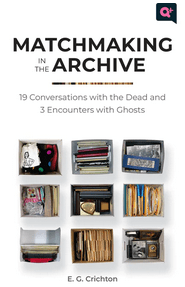 Matchmaking in the Archive
Matchmaking in the Archive
19 Conversations with the Dead and 3 Encounters with Ghosts
by E.G. Crichton
Contributions by Jonathan D. Katz, Michelle Tea, Chris Vargas
228 pages, 24 color illus., 5 x 8
Published by Rutgers University Press
30% OFF + free shipping
rutgersuniversitypress.org or 1 800 621 2736
US orders only • Code: RFLR19
About This Book
Though today’s LGBTQ people owe a lot to the generations who came before them, their historical inheritances are not always obvious. Working with the archives of the Gay Lesbian Bisexual Transgender Historical Society, artist E.G. Crichton decided to do something to bridge this generation gap. She selected 19 innovative LGBTQ artists, writers, and musicians, then paired each of them with a deceased person whose personal artifacts are found in the archive.
What unfolds on these pages are the relationships that emerge between the living and dead participants, and the creative work inspired by those relationships. Matchmaking in the Archive documents this monumental creative project and adds essays by Jonathan Katz, Michelle Tea, and Chris Vargas, who describe their own unique encounters with the ghosts of LGBTQ history. Together, they make the archive come alive in remarkably intimate ways.
About the Author
E.G. CRICHTON is an interdisciplinary artist living in San Francisco, California. Her projects have been exhibited in Asia, Australia, Europe, and across the United States. Crichton is a Professor Emerita at the University of California Santa Cruz, and served as Artist-in-Residence at the Gay Lesbian Bisexual Transgender Historical Society from 2008 to 2014.
Quotes from Reviews
Nico Hall: “…there is a certain and distinct pleasure in a time jump, in nonlinear thinking, in reaching back and forth across decades as though all people from all time, living and dead, are sitting at one table, sharing a meal, passing dishes round and round, sharing and tasting the same things together.”
Nico Hall: “I recently had a younger queer friend ask me how sapphic people found each other in the past. I think I will be sending them this book. We have always been here, in all our complexity, in all the multitudes we contain.”
Mickey Eliason: “One of the visually stunning aspects of the book is the portraits Crichton created of each matched pair by projecting a photo from the archive and posing the living artist/writer in relation to the dead. These photos depict the intimacy that grew in the matched pairs of queer folks who never met each other.”
Reviews
“Matchmaking in the Archive” Connects Today’s Artists and Queer Ancestors by Nico Hall
Book Review Link
Exploring Queer History Through Archives, Art, and Dialogues with the Dead by Mickey Eliason
Book Review Link
Quotes from the Book:
“The black-and-white photographs in her box show groupings of women in uniform, warm expressions indicating they were most likely friends, and I wonder which one of these women broke Harder’s heart. In another photo, from 1945, two couples in civilian clothes are seated in the club Finocchio’s in San Francisco, which was famous for its drag shows. The foursome sits squeezed close together on one side of a table, a man on either end, the two women in the middle. Harder scratched their names in ballpoint pen across the top border: ‘Bobby, me, Toby, Ken.’ At first it appears to be a heterosexual double date, but a closer inspection reveals a view underneath the table of Toby’s hand resting on Harder’s knee in an unmistakably intimate and sexy gesture.”
Crichton recalls encountering Pat Parker in person in line for the bathroom at a concert: “Walking back and forth along the lesbian queue, she prompted our vigilance to the progress of the line: ‘Watch for someone to exit, prepare to unzip your fly” and other time management tips. It was hilarious. Parker was our sexy butch drill sergeant, and we gladly stepped in line.”
“Who are my heirs if I am not married and do not have children? And where will my prized belongings go when I’m gone? What will comprise my archive, my legacy to future generations?”
“The process of opening an archive box, of absorbing what is inside, and what you imagine beyond its confines, brings back a person’s life queerly. A neat linear sequence of time becomes disordered as you relate to the person at all stages of their life. Like any romance, this process is marked by mystery, by the lure of the unknown, and by secrets”
“My role is one part matchmaker, one part art director, one part maker, and one part medium. This is my way of spying on the dead.”
“The matchmaking that forms the core of this project has spawned a rich trove of dialogue, images, objects, writing and above all uncommon relationships.”
My concern is a problem of inheritance: what happens to us when we die? Who will remember us? Will anyone even be interested?
“The intense dyadic relationships that formed in this process evolved into a form of lineage, one that resides outside of bloodlines and marriage contracts and often outside of identity boundaries.”
“LINEAGE: Matchmaking in the Archive was an invitation to wander through one archive, to connect with one person for whom selected artifacts have been preserved. The participants who accepted this invitation became creative agents, free to interpret a life and to invent a response that has been exhibited, performed, read, or listened to by audiences who almost never knew the archived person.”
